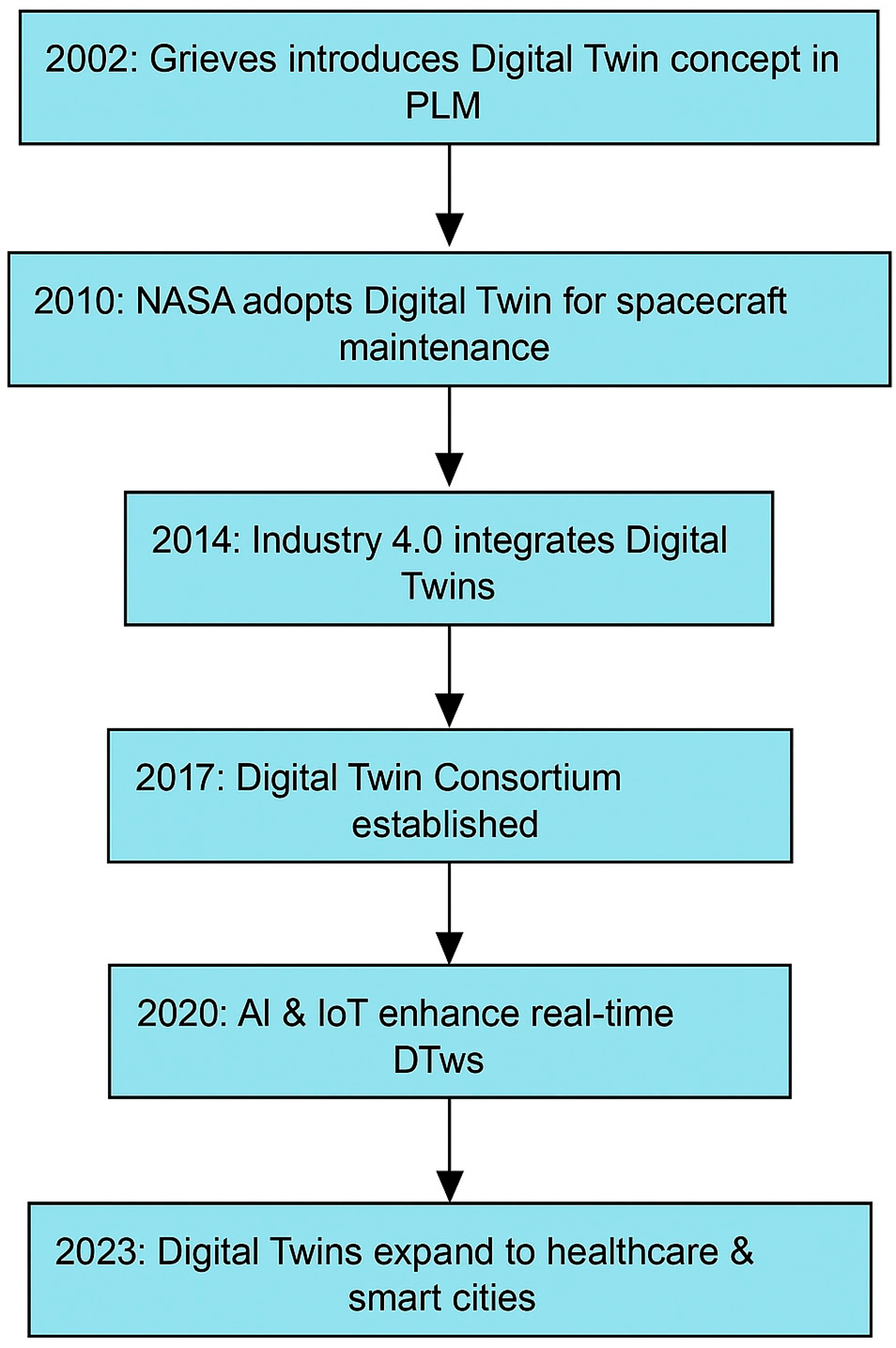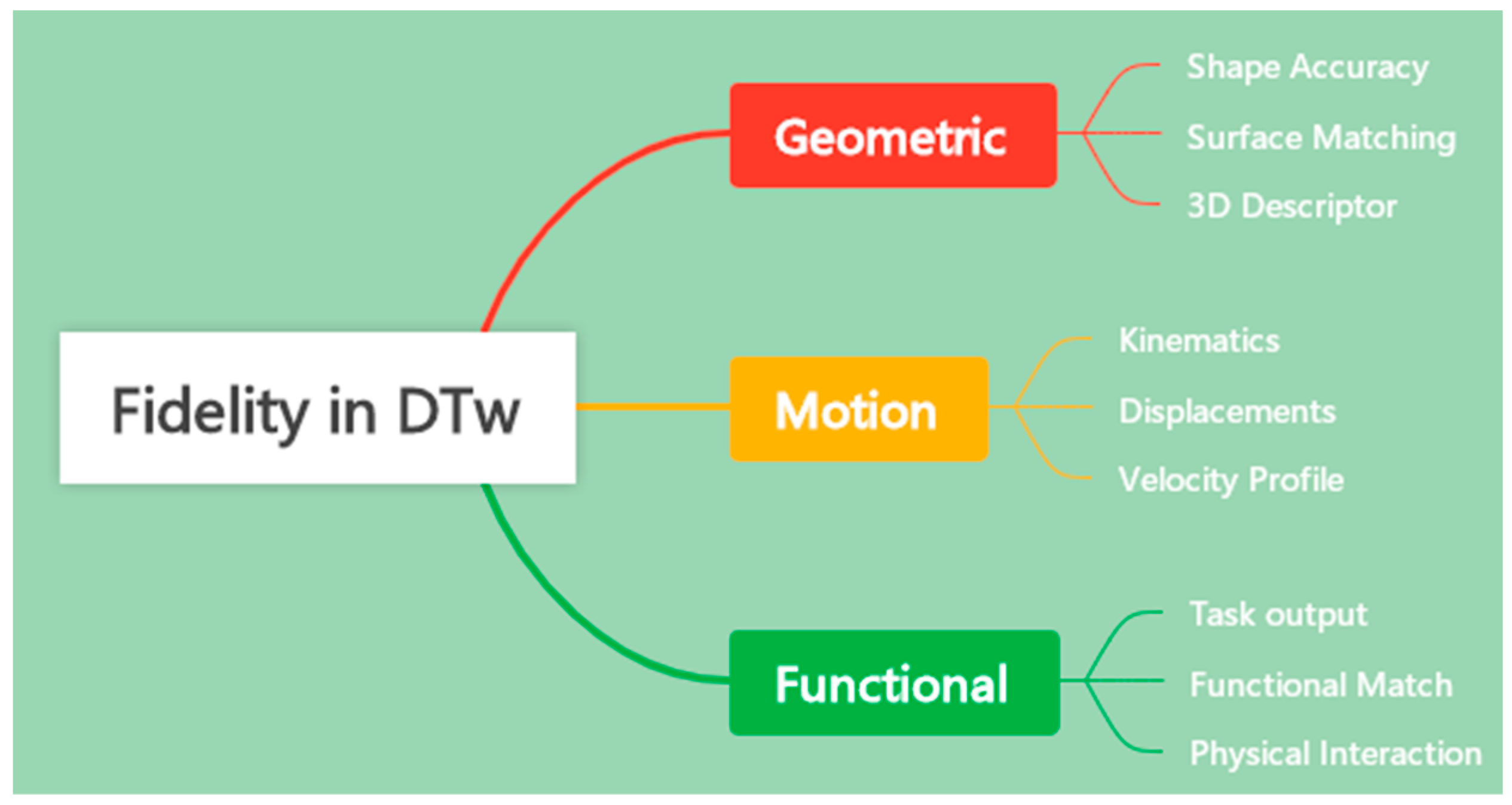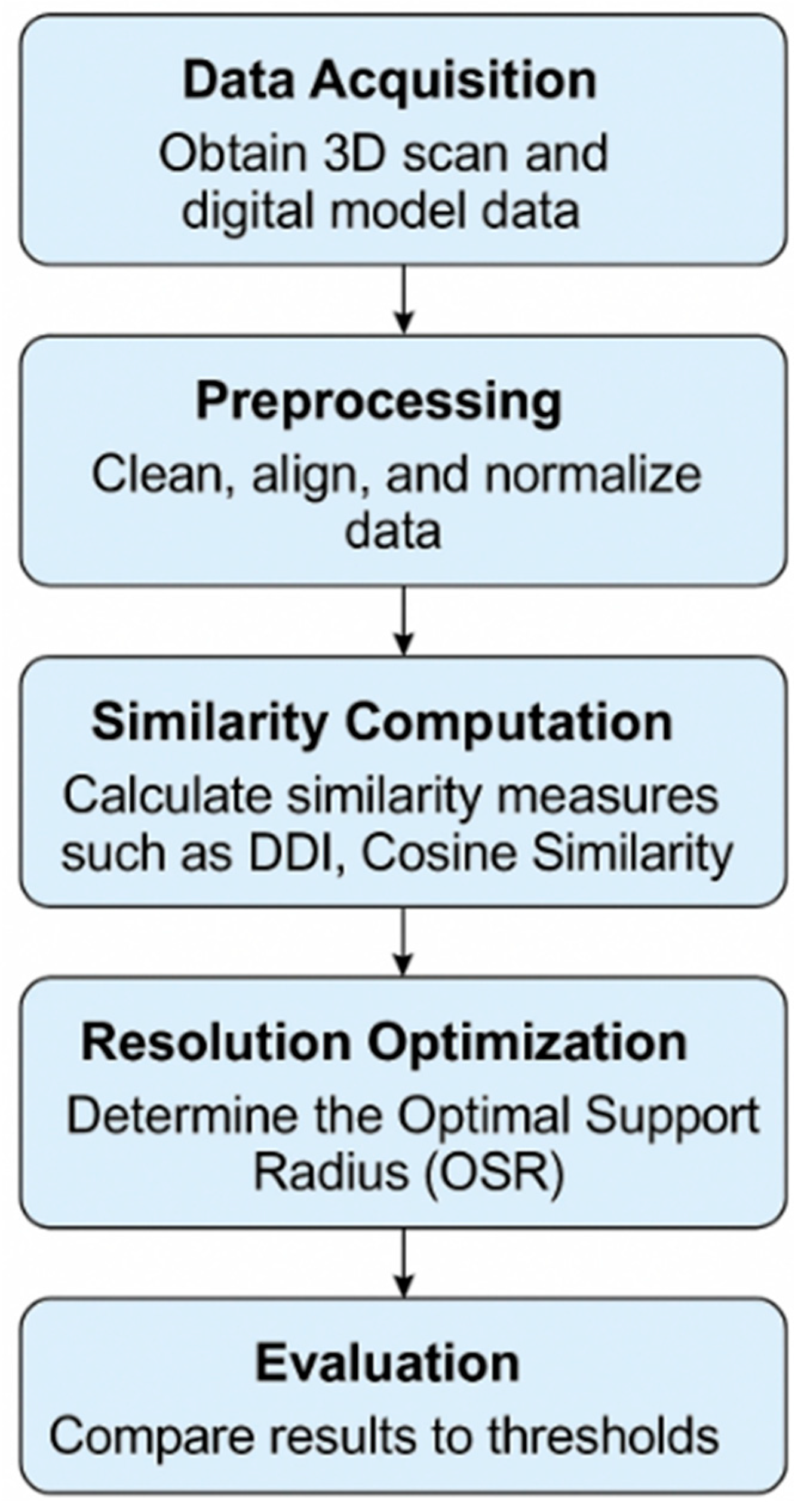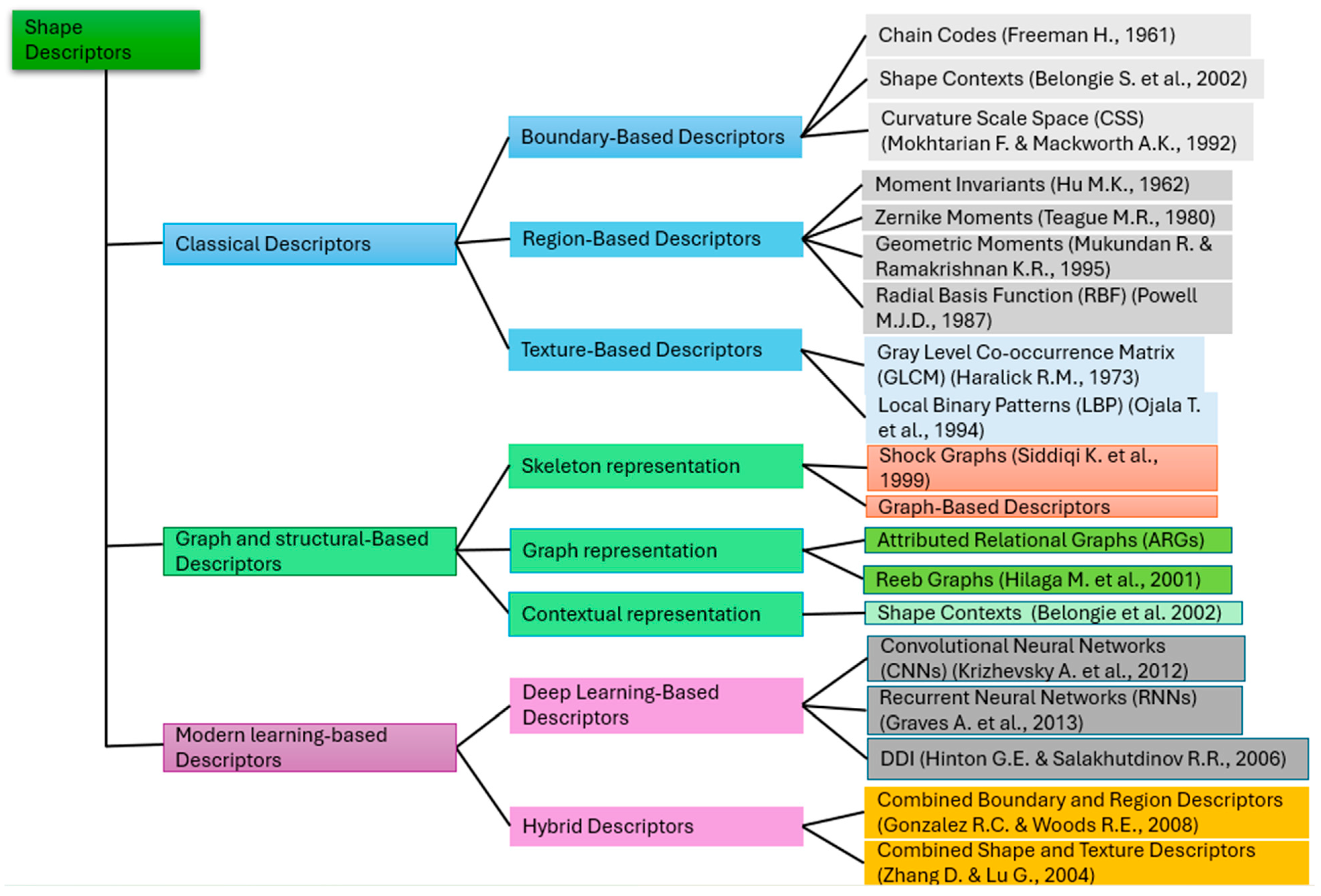A Review of 3D Shape Descriptors for Evaluating Fidelity Metrics in Digital Twin
Abstract
1. Introduction
Historical Development of Digital Twin Technology
- The physical object (real-world system).
- The virtual representation (Digital Twin).
- The data connection (bidirectional flow of information between the physical and virtual environments).
2. Literature Search Methodology
3. Digital Twin Technology
3.1. Applications of Digital Twins in Various Industries
3.2. Challenges in Digital Twin Implementation
4. Fidelity Metrics in Digital Twins
4.1. Definition and Importance of Fidelity Metrics
4.2. Categorization of Fidelity Metrics
4.3. Importance of Fidelity in Critical Applications
4.3.1. Aerospace Industry
4.3.2. Healthcare Industry
4.3.3. Manufacturing and Smart Infrastructure
4.4. Existing Approaches to Fidelity Assessment
4.5. Limitations of Traditional Shape Fidelity Metrics
4.5.1. Lack of Standardization
4.5.2. Inability to Capture Multi-Scale Features
4.5.3. Computational Complexity—Clarifying Simulation vs. Assessment
4.5.4. Data Heterogeneity and Integration Challenges
4.5.5. Network and Latency-Induced Synchronization Issues
4.6. Comparative Analysis of Related Studies
| Study | Year | Focus Area | Geometric Fidelity | Motion Fidelity | Functional Fidelity | Standardization Insight | Key Contribution |
|---|---|---|---|---|---|---|---|
| Tangelder & Veltkamp [7] | 2008 | 3D shape retrieval methods | ✔ In-depth | ✖ Not addressed | ✖ Not addressed | ✖ Not discussed | Comprehensive survey of 3D shape descriptors for retrieval purposes. |
| Tao et al. [2] | 2019 | DTw architecture and applications | ✔ Broad concepts | ✔ General behaviors | ✔ General behaviors | ✖ Not specific | Proposed a conceptual framework for DTws, including fidelity considerations. |
| Negri et al. [26] | 2017 | DTw in manufacturing | ✔ Point cloud, geometry | ✔ Simulated behavior | ✔ Simulated behavior | ✖ No ISO link | Discussed shape and simulation fidelity in manufacturing contexts. |
| Fuller et al. [4] | 2020 | DTw enabling technologies | ✔ Mentioned | ✔ Latency and synchronization | ✔ Latency & synchronization | ✖ General observations | Identified challenges and open questions in DTw standardization. |
| Kim et al. [23] | 2023 | Fidelity design model for DTws | ✔ Detailed | ✔ Detailed | ✔ Detailed | ✔ ISO-aligned | Introduced concepts of similarity, correspondence, and fidelity in DTws. |
| Desai et al. [40] | 2023 | Multi-fidelity modeling and uncertainty quantification | ✔ Surrogate models | ✔ Surrogate models | ✔ Surrogate models | ✖ Not discussed | Proposed a framework for enhanced multi-fidelity modeling in DTws. |
| Agapaki & Brilakis [39] | 2022 | Geometric DTws for industrial facilities | ✔ Deep learning-based | ✖ Not addressed | ✖ Not addressed | ✖ Not discussed | Developed a method for retrieving industrial shapes for geometric DTws. |
| Sharma et al. [41] | 2022 | State of the art in DTw theory and practice | ✔ Overview | ✔ Overview | ✔ Overview | ✖ Not specific | Reviewed DTw features, challenges, and open research questions. |
| ISO/IEC AWI TR 30138 [8] | 2025 | Fidelity metric standard for DTw systems | ✔ Under development | ✔ Under development | ✔ Under development | ✔ ISO standard | Establishing a standardized approach to DTw fidelity metrics. |
| This paper (Current Study) | 2025 | Shape fidelity evaluation in DTws | ✔ Deep comparison, taxonomy | ✔ Motion/functional reclassification | ✔ Motion/functional reclassification | ✔ Linked to ISO 30138 | Proposes a fidelity metric centered on 3D shape descriptor evaluation, aligned with ISO 30138. |
5. Shape Descriptors: A Key Component for Fidelity Metrics
5.1. Historical Development and Types of Shape Descriptors
5.2. Comparative Evaluation of Shape Descriptors
6. Digital Twin Standardization and ISO 30138
6.1. Ongoing Standardization Efforts
6.2. Challenges to Achieving Universal Standardization
7. Future Directions in Digital Twin Research
7.1. Innovations in Fidelity Metrics
7.2. Focused Research Directions in Shape Fidelity
7.2.1. Fidelity Metric for Shape Descriptor Mapping
7.2.2. ISO 30138-Informed Fidelity Classification Framework
7.2.3. Descriptor-Aware Benchmarking Protocols and Datasets
7.2.4. Domain-Specific Shape Fidelity Profiles
7.2.5. Implementation Workflow Overview
8. Conclusions
Author Contributions
Funding
Conflicts of Interest
Appendix A. Mathematical Definitions of Fidelity Metrics
Appendix A.1. Descriptor Distance Index (DDI)
- Interpretation: A DDI value of 0 indicates identical feature vectors, while higher values represent greater dissimilarity.
- Normalization: The denominator ensures the metric is scale-invariant across different feature magnitudes.
Appendix A.2. Optimal Support Radius (OSR)
- is the descriptor distance index at radius
- is a similarity-based measure (e.g., cosine similarity) at radius ,
- are weights reflecting the importance of each term.The OSR is defined as:
- Interpretation: The selected OSR represents the radius that produces the optimal trade-off between feature similarity and resolution cost.
References
- Kagermann, H.; Wahlster, W.; Helbig, J. Recommendations for Implementing the Strategic Initiative INDUSTRIE 4.0; Final Report of the Industrie 4.0 Working Group; Acatech: Munich, Germany, 2013. [Google Scholar]
- Tao, F.; Sui, F.; Liu, A.; Qi, Q.; Zhang, M.; Song, B.; Guo, Z.; Lu, S.C.; Nee, A.Y.C. Digital Twin-Driven Product Design, Manufacturing and Service with Big Data. Int. J. Adv. Manuf. Technol. 2019, 94, 3563–3576. [Google Scholar] [CrossRef]
- Rosen, R.; Wichert, G.; Lo, G.; Bettenhausen, K.D. About the Importance of Autonomy and Digital Twins for the Future of Manufacturing. IFAC-PapersOnLine 2015, 48, 567–572. [Google Scholar] [CrossRef]
- Fuller, A.; Fan, Z.; Day, C.; Barlow, C. Digital Twin: Enabling Technologies, Challenges, and Open Research. IEEE Access 2020, 8, 108952–108971. [Google Scholar] [CrossRef]
- Tuegel, E.J.; Ingraffea, A.R.; Eason, T.G.; Spottswood, S.M. Reengineering Aircraft Structural Life Prediction Using a Digital Twin. Int. J. Aerosp. Eng. 2011, 2011, 154798. [Google Scholar] [CrossRef]
- Zhang, D.; Lu, G. Review of Shape Representation and Description Techniques. Pattern Recognit. 2004, 37, 1–19. [Google Scholar] [CrossRef]
- Tangelder, J.W.; Veltkamp, R.C. A Survey of Content Based 3D Shape Retrieval Methods. In Proceedings of the Shape Modeling Applications, Genova, Italy, 7–9 June 2008; pp. 145–156. [Google Scholar]
- ISO/IEC AWI TR 30138; Internet of Things (IoT)—Digital Twin—Fidelity Metrics and Quantification Methods. ISO/IEC JTC 1/SC 41: Geneva, Switzerland, 2025.
- Grieves, M. Digital Twin: Manufacturing Excellence through Virtual Factory Replication; White Paper; University of Michigan: Ann Arbor, MI, USA, 2003. [Google Scholar]
- Grieves, M.; Vickers, J. Digital Twin: Mitigating Unpredictable, Undesirable Emergent Behavior in Complex Systems. In Transdisciplinary Perspectives on Complex Systems; Springer: Cham, Switzerland, 2017; pp. 85–113. [Google Scholar]
- Khan, M.T.H.; Rezwana, S. A Review of CAD to CAE Integration with a Hierarchical Data Format (HDF)-Based Solution. J. King Saud Univ.–Eng. Sci. 2021, 33, 248–258. [Google Scholar] [CrossRef]
- Shafto, M.; Conroy, M.; Doyle, R.; Glaessgen, E.; Kemp, C.; LeMoigne, J.; Wang, L. Modeling, Simulation, Information Technology & Processing Roadmap; NASA: Washington, DC, USA, 2012.
- Bruynseels, K.; De Sio, F.; van den Hoven, J. Digital Twins in Health Care: Ethical Implications of an Emerging Engineering Paradigm. Front. Genet. 2018, 9, 31. [Google Scholar] [CrossRef]
- Boschert, S.; Rosen, R. Digital Twin—The Simulation Aspect. In Mechatronic Futures; Springer: Cham, Switzerland, 2016; pp. 59–74. [Google Scholar]
- Page, M.J.; McKenzie, J.E.; Bossuyt, P.M.; Boutron, I.; Hoffmann, T.C.; Mulrow, C.D.; Shamseer, L.; Tetzlaff, J.M.; Akl, E.A.; Brennan, S.E.; et al. The PRISMA 2020 statement: An updated guideline for reporting systematic reviews. BMJ 2021, 372, n71. [Google Scholar] [CrossRef]
- Khan, M.T.H.; Demoly, F.; Kim, K.Y. Constructing Assembly Design Model Capable of Capturing and Sharing Semantic Dynamic Motion Information in Heterogeneous CAD Systems. Int. J. Adv. Manuf. Technol. 2020, 111, 945–961. [Google Scholar] [CrossRef]
- Kritzinger, W.; Karner, M.; Traar, G.; Henjes, J.; Sihn, W. Digital Twin in Manufacturing: A Categorical Literature Review and Classification. IFAC-PapersOnLine 2018, 51, 1016–1022. [Google Scholar] [CrossRef]
- Harris, J.; Ives, B.; Junglas, I. IT Alignment in Critical Areas of Digital Transformation. Eur. J. Inf. Syst. 2020, 29, 213–232. [Google Scholar]
- Johnson, R.; Fournier, Q.; Medsker, L. Predictive Maintenance Techniques Designed for Diagnostic Data Collected from Commercial Aircraft Engines. J. Eng. Gas Turbines Power 2017, 139, 122801. [Google Scholar]
- Brown, R.; O’Brien, J.; McGlade, C. Realizing the Benefits of Digital Twin Technology in Industrial Settings. J. Manuf. Syst. 2019, 54, 170–181. [Google Scholar]
- Smith, L.; Beck, M.; An, B. Digital Twin: Bridging the Physical and Digital Domains for Personalized Healthcare. IEEE Trans. Biomed. Eng. 2020, 68, 1224–1236. [Google Scholar]
- Lee, J.; Bagheri, B.; Kao, H.-A. A Cyber-Physical Systems Architecture for Industry 4.0-Based Manufacturing Systems. Manuf. Lett. 2018, 15, 18–23. [Google Scholar] [CrossRef]
- Kim, J.; Zhao, L.; Chen, X. Deep Learning-Driven Fidelity Optimization in Digital Twins. AI Digit. Eng. 2023, 18, 101–118. [Google Scholar]
- Taylor, S.; Peppard, J.; Coleman, G. Challenges of Digital Transformation: The Need for a Digital Twin Strategy. J. Inf. Technol. 2022, 37, 77–100. [Google Scholar]
- O’Donovan, P.; Leahy, K.; Bruton, K.; O’Sullivan, D.T.J. Cybersecurity Challenges in the Uptake of Digitalizing Infrastructure. IEEE Secur. Priv. 2019, 17, 49–58. [Google Scholar]
- Negri, E.; Fumagalli, L.; Macchi, M. A Review of the Roles of Digital Twin in CPS-Based Production Systems. Procedia Manuf. 2017, 11, 939–948. [Google Scholar] [CrossRef]
- Glaessgen, E.H.; Stargel, D.S. The Digital Twin Paradigm for Future NASA and U.S. Air Force Vehicles. In Proceedings of the 53rd AIAA/ASME/ASCE/AHS/ASC Structures, Structural Dynamics and Materials Conference, Honolulu, HI, USA, 23–26 April 2012; p. 1818. [Google Scholar]
- ISO/TR 24464:2025; Automation Systems and Integration—Industrial Data—Visualization Elements of Digital Twins. International Organization for Standardization: Geneva, Switzerland, 2025.
- ISO/AWI TS 25271; Automation Systems and Integration—Industrial Digital Twin Interface Architecture. International Organization for Standardization: Geneva, Switzerland, Under Development.
- Brigham, E.O. The Fast Fourier Transform and Its Applications; Prentice-Hall: Englewood Cliffs, NJ, USA, 1974. [Google Scholar]
- Belongie, S.; Malik, J.; Puzicha, J. Shape Matching and Object Recognition Using Shape Contexts. IEEE Trans. Pattern Anal. Mach. Intell. 2002, 24, 509–522. [Google Scholar] [CrossRef]
- Kokkinos, I.; Kosmopoulos, D.; Perantonis, S. 3D Shape Descriptor for Object Recognition Based on Kinect-Like Depth Image. Image Vis. Comput. 2014, 32, 533–549. [Google Scholar] [CrossRef]
- Xu, Y.; Min, Z.; Xu, M.; Zhang, H. ShapeBench: A New Approach to Benchmarking Local 3D Shape Descriptors. Comput. Graph. 2024, 125, 104052. [Google Scholar]
- Krizhevsky, A.; Sutskever, I.; Hinton, G.E. ImageNet Classification with Deep Convolutional Neural Networks. Adv. Neural Inf. Process. Syst. 2012, 25, 1097–1105. [Google Scholar] [CrossRef]
- Zhang, D.; Lu, G. Advances in 3D Shape Descriptors for Digital Twin Fidelity Evaluation. Pattern Recognit. 2023, 57, 331–349. [Google Scholar]
- Teague, M.R. Image Analysis via the General Theory of Moments. J. Opt. Soc. Am. 1980, 70, 920–930. [Google Scholar] [CrossRef]
- Kuhl, F.P.; Giardina, C.R. Elliptic Fourier Features of a Closed Contour. Comput. Graph. Image Process. 1982, 18, 236–258. [Google Scholar] [CrossRef]
- Qi, C.R.; Su, H.; Mo, K.; Guibas, L.J. PointNet: Deep Learning on Point Sets for 3D Classification and Segmentation. In Proceedings of the IEEE Conference on Computer Vision and Pattern Recognition (CVPR), Honolulu, HI, USA, 21–26 July 2017; pp. 652–660. [Google Scholar]
- Agapaki, E.; Brilakis, I. Geometric Digital Twins for Industrial Facilities: A Method for 3D Shape Retrieval from Images. arXiv 2022, arXiv:2202.04834. [Google Scholar]
- Desai, S.; Naveneeth, N.; Adhikari, S.; Chakraborty, S. Digital Twin Fidelity: A Taxonomy for Classification and Comparison. arXiv 2023, arXiv:2306.14430. [Google Scholar]
- Sharma, A.; Kosasih, E.; Zhang, J.; Brintrup, A.; Calinescu, A. Digital Twins: State of the Art Theory and Practice, Challenges, and Open Research Questions. J. Ind. Inf. Integr. 2022, 30, 100383. [Google Scholar] [CrossRef]
- Mokhtarian, F.; Mackworth, A.K. A Theory of Multiscale, Curvature-Based Shape Representation for Planar Curves. IEEE Trans. Pattern Anal. Mach. Intell. 1992, 14, 789–805. [Google Scholar] [CrossRef]
- Freeman, H. On the Encoding of Arbitrary Geometric Configurations. IRE Trans. Electron. Comput. 1961, EC-10, 260–268. [Google Scholar] [CrossRef]
- Hu, M.K. Visual Pattern Recognition by Moment Invariants. IRE Trans. Inf. Theory 1962, 8, 179–187. [Google Scholar]
- Powell, M.J.D. Radial basis functions for multivariable interpolation: A review. In Algorithms for Approximation; Mason, J.C., Cox, M.G., Eds.; Clarendon Press: Oxford, UK, 1987; pp. 143–167. [Google Scholar]
- Haralick, R.M.; Shanmugam, K.; Dinstein, I. Textural Features for Image Classification. IEEE Trans. Syst. Man Cybern. 1973, SMC-3, 610–621. [Google Scholar] [CrossRef]
- Ojala, T.; Pietikäinen, M.; Harwood, D. Performance Evaluation of Texture Measures with Classification Based on Kullback Discrimination of Distributions. In Proceedings of the 12th IAPR International Conference on Pattern Recognition, Jerusalem, Israel, 9–13 October 1994; pp. 582–585. [Google Scholar]
- Tian, G.; Sheng, H.; Zhang, L.; Zhang, H.; Fathollahi-Fard, A.M.; Zhang, X.; Feng, Y. Enhancing End-of-Life Product Recyclability through Modular Design and Social Engineering Optimiser. Int. J. Prod. Res. 2024, 62, 1–19. [Google Scholar] [CrossRef]
- Siddiqi, K.; Shokoufandeh, A.; Dickinson, S.J.; Zucker, S.W. Shock Graphs and Shape Matching. Int. J. Comput. Vis. 1999, 35, 13–32. [Google Scholar] [CrossRef]
- Sanfeliu, A.; Alquézar, R.; Andrade, J.; Climent, J.; Serratosa, F.; Verges, J. A Review on Graph-Based Representations in Pattern Recognition. Pattern Recognit. 2004, 36, 35–60. [Google Scholar]
- Graves, A.; Mohamed, A.-R.; Hinton, G. Speech Recognition with Deep Recurrent Neural Networks. In Proceedings of the 2013 IEEE International Conference on Acoustics, Speech and Signal Processing, Vancouver, BC, Canada, 26–31 May 2013; pp. 6655–6659. [Google Scholar]
- Hinton, G.E.; Salakhutdinov, R.R. Reducing the Dimensionality of Data with Neural Networks. Science 2006, 313, 504–507. [Google Scholar] [CrossRef]
- Esteva, A.; Kuprel, B.; Novoa, R.A.; Ko, J.; Swetter, S.M.; Blau, H.M.; Thrun, S. Dermatologist-Level Classification of Skin Cancer with Deep Neural Networks. Nature 2017, 542, 115–118. [Google Scholar] [CrossRef]
- Digital Twin Consortium. Digital Twin Consortium Home. Available online: https://www.digitaltwinconsortium.org/ (accessed on 19 June 2025).
- Lu, Y.; Liu, C.; Wang, K.I.-K.; Huang, H.; Xu, X. Digital Twin-Driven Smart Manufacturing: Connotation, Reference Model, Applications, and Research Issues. Robot. Comput.-Integr. Manuf. 2020, 61, 101837. [Google Scholar] [CrossRef]
- Wang, X.; Shen, H.; Zhang, D. AI-Driven Dynamic Fidelity Improvement in Digital Twins. Comput. Intell. J. 2023, 41, 121–139. [Google Scholar]
- García, F.; Li, H.; Xu, T. A Probabilistic Approach for Digital Twin Fidelity Assessment. J. Adv. Comput. Syst. 2023, 34, 215–233. [Google Scholar]
- Khan, M.T.H.; Noh, C.; Abbas, T.; Han, S. Digital Twin Similarity: Fidelity Metric with 3D Shape Descriptor. Manuscr. Prep. under preparation.
- Lu, Y.; Liu, K.; Wang, P.; Huang, Z. Digital Twin Integration in Smart Grid Technologies: Challenges and Opportunities. IEEE Trans. Smart Syst. 2023, 17, 89–107. [Google Scholar]
- Tao, F.; Zhang, M.; Liu, Y.; Nee, A.Y.C. Standardizing Digital Twin Fidelity Assessment: A Comprehensive Framework. J. Ind. Inform. 2023, 29, 541–557. [Google Scholar]
- Khan, T.H.; Noh, C.; Han, S. Correspondence Measure: A Review for the Digital Twin Standardization. Int. J. Adv. Manuf. Technol. 2023, 128, 1907–1927. [Google Scholar] [CrossRef]





| Industry | Key Applications | Primary Benefits | Real-World Example |
|---|---|---|---|
| Aerospace | -Real-time component monitoring -Predictive maintenance -Engine performance modeling | -Reduced failures -Lower maintenance costs -Enhanced flight safety | Rolls-Royce jet engine monitoring and failure prediction [19] |
| Healthcare | -Organ modeling -Treatment simulation -Disease progression prediction | -Non-invasive interventions -Personalized medicine -Reduced treatment risks | Cardiac intervention planning for personalized treatment [21] |
| Manufacturing | -Production line optimization -Quality control -Supply chain management | -Operational cost reduction -Defect prevention -Enhanced efficiency | Factory digital replica for workflow testing and bottleneck prediction [20] |
| Automotive | -Vehicle performance simulation -Crash testing -Autonomous driving development | -Improved safety standards -Fuel efficiency gains -Reduced R&D costs | Virtual testing environments for self-driving algorithms [22] |
| Challenge | Key Issues | Impact | Mitigation Approaches |
|---|---|---|---|
| Interoperability | -Non-standardized data formats -Incompatible communication protocols | -Limited system integration -Reduced collaboration efficiency | Universal framework development [23] |
| Scalability | -Massive IoT/sensor data volumes -Computational resource limitations | -System responsiveness issues -Performance degradation at scale | High-performance computing infrastructure [5] |
| Standardization Gap | -Absence of unified frameworks -Inconsistent implementation methodologies | -Benchmarking difficulties -Validation challenges | Industry-wide standards adoption [24] |
| Security & Privacy | -Cyber-attack vulnerability -Data breach risks -IP theft threats | -Critical infrastructure disruptions -Loss of sensitive data | Encryption and continuous monitoring [25] |
| Implementation Costs | -High IoT/cloud infrastructure investment -Specialized training requirements | -Limited SME adoption -ROI achievement delays | Modular deployment strategies [18] |
| Criterion | Boundary-Based | Region-Based | Texture Based | Structural | Fourier-Based | Deep Learning Based (3D Shape Descriptor) | Hybrid |
|---|---|---|---|---|---|---|---|
| Translation Invariance | ✔ | ✔ | ✔ | ✔ | ✔ | ✔ | ✔ |
| Rotation Invariance | ✔ | ✔ | ✔ | ✔ | ✔ | ✔ | ✔ |
| Scale Invariance | ✔ | ✔ | ✔ | ✔ | ✔ | ✔ | ✔ |
| Handling of Noise and Distortion | ✖ | ✖ | ⭘ | ⭘ | ✖ | ✔ | ⭘ |
| Representation of Complex Shapes | ⭘ | ✔ | ✔ | ✔ | ✖ | ✔ | ✔ |
| Computational Efficiency | ✔ | ✔ | ⭘ | ✖ | ✔ | ✔ | ⭘ |
| Robustness of Occlusion | ✖ | ✖ | ✖ | ⭘ | ✖ | ✔ | ⭘ |
| Ability to Learn from Data | ✖ | ✖ | ✖ | ✖ | ✖ | ✔ | ✔ |
| Generalization to Unseen Data | ✖ | ✖ | ✖ | ✖ | ✖ | ✔ | ⭘ |
| Flexibility for different domains | ✖ | ✔ | ✔ | ✔ | ✖ | ✔ | ⭘ |
Disclaimer/Publisher’s Note: The statements, opinions and data contained in all publications are solely those of the individual author(s) and contributor(s) and not of MDPI and/or the editor(s). MDPI and/or the editor(s) disclaim responsibility for any injury to people or property resulting from any ideas, methods, instructions or products referred to in the content. |
© 2025 by the authors. Licensee MDPI, Basel, Switzerland. This article is an open access article distributed under the terms and conditions of the Creative Commons Attribution (CC BY) license (https://creativecommons.org/licenses/by/4.0/).
Share and Cite
Khan, M.T.H.; Han, S.; Jauhar, T.A.; Noh, C. A Review of 3D Shape Descriptors for Evaluating Fidelity Metrics in Digital Twin. Machines 2025, 13, 750. https://doi.org/10.3390/machines13090750
Khan MTH, Han S, Jauhar TA, Noh C. A Review of 3D Shape Descriptors for Evaluating Fidelity Metrics in Digital Twin. Machines. 2025; 13(9):750. https://doi.org/10.3390/machines13090750
Chicago/Turabian StyleKhan, Md Tarique Hasan, Soonhung Han, Tahir Abbas Jauhar, and Chiho Noh. 2025. "A Review of 3D Shape Descriptors for Evaluating Fidelity Metrics in Digital Twin" Machines 13, no. 9: 750. https://doi.org/10.3390/machines13090750
APA StyleKhan, M. T. H., Han, S., Jauhar, T. A., & Noh, C. (2025). A Review of 3D Shape Descriptors for Evaluating Fidelity Metrics in Digital Twin. Machines, 13(9), 750. https://doi.org/10.3390/machines13090750








